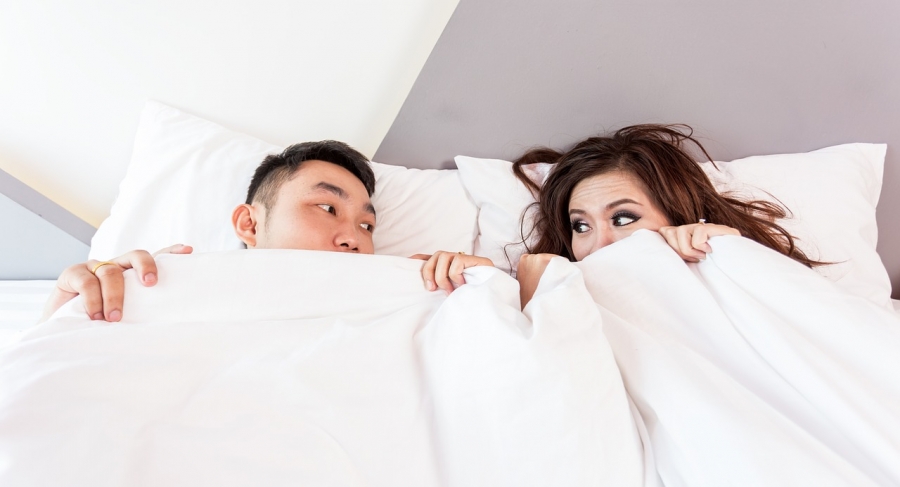Sleep can be beautiful or challenging in regards to a suitable position, temperature, subduing stressors of the day, shutting out the rest of the world…etcetera. Most of us are lucky to get five or six hours of sleep and find the goal of 8 blissful hours of sleep a struggle to achieve.
8 SLEEP OBSTACLES + 8 SLEEP FIXES
OUTSIDE LIGHT: Natural light is a huge selling point when you’re buying a home and something you’ll enjoy during the day. But streetlights and other light pollution are not exactly desirable at night.
“People who live in more densely populated areas that are lit at night with bright street lights or signs are more likely to report trouble sleeping, suggests new research from Stanford Sleep Epidemiology Research Center in California,” said the Cleveland Clinic. “People with high nighttime light exposure, for example, were more likely than those in low-lit regions of the country to be dissatisfied with their sleep quantity or quality, the findings showed.”
DRAPES: A good window covering like blackout drapes can mean the difference between a restful sleep and a restless night, limiting the light that gets in so your natural circadian rhythm, which “causes you to feel more alert or sleepy, depending on the time of the day,” can do its thing.
INSIDE LIGHT: Many a bedroom has a bright overhead light and nothing more. But that can mean a room that isn’t properly lit for function or feeling. “Knowing how to layer your lighting is the key to creating the best lighting your bedroom,” said Y Lighting. “This means finding the right balance between ambient, task, and accent lighting. By creating this balance, you will be able to create the lighting for any mood and any activity with the flick of a switch.”
DIMMER: If your bedroom is lit from above and you don’t want to change it, at least get a dimmer.
PAINT COLOR: “Are there any colors you should avoid painting your bedroom walls? People with gray, brown, or purple bedrooms regularly slept unhealthy amounts of fewer than 7 hours of sleep per night,” according to a new study, said Tuck. “At 5 hours and 56 minutes of sleep, purple is the worst color for sleep. It’s a mentally stimulating color, boosting your creativity and contributing to more vivid nightmares.” Gray is said to be depressing and uninspired, while brown “is drab, gloomy, and anything but cozy. It tends to create a sense of restlessness instead of calm.” On the other hand, “Red is a passionate, energetic color that can increase your blood pressure and inspire you to move faster. Neither of these are physical sensations that promote sleep.”
STRESS: Sometimes, we have no option but to incorporate a workstation in our bedroom. But doing so can cause unnecessary stress if you don’t create a separation between your workspace and your sleep space. The more serene you can make your space, the more you can set yourself up for a good night’s sleep.
SERENITY: “Your bedroom should be quiet and serene, a place to relax and recharge,” designer Maggie Griffin said on Yahoo. “Avoid furniture that will clutter your space with display items, like curio cabinets.”
NOISE: Outside noise can also keep you from getting to sleep—or staying that way. You may not be able to do anything about the car traffic on your street or your noisy teenage neighbor, but there are some ways to mitigate the noise from inside your home.
It may surprise you to learn that even when you’re sleeping, noises can still be disruptive enough to wake you,” said SleepScore Labs. “What’s more surprising is these sounds don’t even have to wake you to interfere with sleep, since the sleeping brain remains aware of sounds in the environment. Because of that, you might suffer from a restless sleep that leaves you tired because you did not spend enough time in deep and REM sleep, the deepest and most restorative sleep cycles.”
Two viable suggestions for lowering the noise quotient: Get a white noise machine. “White noise machines are a wise investment for those who struggle to sleep due to noisy sleeping environments. For example, those moving from a rural to an urban setting can benefit from white noise machines that cover sudden loud noises with a continuous sound. There are also pink noises, like the sound of steady rainfall, and brown noises, like the roar of a river, which work well, too.” You can also consider modifying your bedroom layout. “This involves moving furniture to optimal locations to reduce noise, adding sound-proofing panels to the walls where noise enters, and insulating floors, windows, and ceilings safely.”
WALLPAPER: Yes, wallpaper is back. And it can look great everywhere, including on the walls of your bedroom. However, going with a busy pattern in what is supposed to be a restful space may end up keeping you up at night.
BED QUALITY: For sleep’s sake, splurge on the good mattress. Isn’t it funny how we’ll spend a month’s salary on the fancy couch or the dining table that seats 10 (and that we only use once a year), but when it comes to our bed, we cheap out? After all, the average American spends “11 hours a day lying on their bed — that’s nearly half of our lifetime,” according to the New York Post.
An uncomfortable bed can keep you from getting to sleep, staying asleep, and getting restful, restorative sleep—and that can have a real impact on our health, both physical and mental.
INVEST in a GOOD NIGHT’s SLEEP: Put some money into it. Your mattress doesn’t have to cost as much as your car, but an investment in a good bed is an investment in your sleep—and your health.


